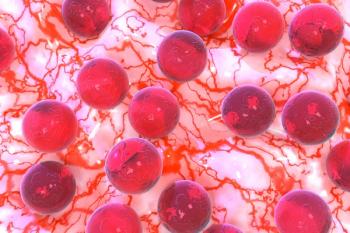
Addition of Elotuzumab to KRd Yields Promising Responses in Newly Diagnosed Multiple Myeloma
Results from a phase 2 study indicated that adding elotuzumab to carfilzomib, lenalidomide, and dexamethasone with a minimal residual disease–adapted design boosted responses for those with newly diagnosed multiple myeloma.
Durable, robust responses and promising minimal residual disease (MRD) negativity were observed following treatment with elotuzumab (Empliciti) plus weekly carfilzomib (Kyprolis), lenvatinib (Revlimid), and dexamethasone (KRd) with an MRD-adapted design for patients with newly diagnosed multiple myeloma who did not receive autologous stem cell transplant (ASCT), according to results from a phase 2 study (NCT02969837).
After 8 cycles of therapy, a total of 58% of patients achieved stringent complete response (sCR) and/or MRD negativity. By cycle 8, a MRD-negativity rate of 10–5 was reported om 70% of patients and after cycle 8 60% of patients had an MRD of 10–6. Moreover, between cycles 8 and 12, 44% of patients had an MRD-negativity of 10–5.
A total of 46 patients with newly diagnosed disease were enrolled with a median age of 62 years. A total of 45 patients were evaluable for response after 8 cycles, as 1 patient received ASCT prior to cycle 8. The median duration of treatment was 18 cycles with 6 patients receiving ASCT off treatment.
Investigators reported that 58% of patients (95% CI, 42%-73%) reached the primary end point of sCR and/or MRD-negativity following 8 cycles of treatment. Moreover, 38% of patients achieved an sCR, 47% had a CR or better, 84% had a very good partial response (VGPR) or better, and 87% had a partial response (PR) or better after 8 cycles. One patient discontinued treatment early because of toxic effects, with 1 patient dying during cycle 2. Of those who experienced disease progression prior to cycle 8 (n = 4), investigators reported that they had 17p deletion and/or 1q amplification.
Within the intent-to-treat population, 57% of patients had a sCR, 70% had a CR or better, 93% had a VGPR or better, and 96% had a PR or better. The rate of CR or better as a best response was observed in 78% of patients with standard-risk and 64% with high-risk cytogenetics (P = .34).
After cycle 8, 29% of patients at the 10-5 threshold and 26% at the 10-6 threshold converted from MRD positive to MRD negative at later time points. Long-term MRD-negativity was observed in 50% of patients with a single report of progression at 34 months. In the standard-risk cytogenetics group, 70% were MRD negative after cycle 8, and 78% were MRD negative as a best response. In the high-risk cytogenetics population, 45% were MRD negativity after cycle 8, and 55% had MRD negativity as their best response.
MRD negativity at cycle 8 was associated with superior progression-free survival (PFS) and overall survival (OS) compared with the MRD-positive group. One patient had disease progression but was alive at the last follow-up and 30 patients achieved MRD-negativity with no statistical difference in PFS by cytogenetic risk.
Mass spectrometry was used in 57% of patients with available samples. After 8 cycles, the mass spectrometry negativity rate was 31% with a best response rate of 65% when patients later converted. At cycle 8, investigators reported a 54% had agreement of 24 paired mass spectrometry and next-generation sequencing (NGS) samples (Cohen κ, 0.12; 95% CI, –0.21 to 0.45). Among these, 2 cases were NGS positive or mass spectrometry negative, and 9 cases were NGS negative or mass spectrometry positive. At later time points, there was an 87% agreement in 23 samples in cycle 12 (Cohen κ, 0.74; 95% CI, 0.46-1.0) with 2 cases being NGS positive or mass spectrometry negative and 1 case being NGS negative and mass spectrometry positive.
In total, 61% of patients transitioned to the combination as a maintenance regimen, with 43% doing so after cycle 12, 4% after cycle 18, and 13% after cycle 24. MRD-negativity was observed in all patients who transitioned to maintenance therapy after cycle 12. However, 1 patient was at the MRD 10–5 but MRD positive at 10–6. Treatment continued in 13% of patients after the cut off date, and 26% had discontinued before completing treatment. Twenty percent of patients withdrew from maintenance to pursue single-agent maintenance therapy.
The study’s median follow-up was 28.7 months and included 9 progression events and 8 deaths, while the median PFS and OS have not been reached. At 3 years, the estimated PFS rate was 72% and OS was 78%. At cycle 8, the estimated 3-year PFS rate for those with MRD negativity at a threshold of 10–5 was 92% and OS was 100%. For those with standard-risk cytogenetics, the 3-year PFS rate and OS rate were 86% and 91%, and 61% and 64%, respectively, for high-risk cytogenetics.
Grade 3/4 hematologic adverse effects included neutropenia (11%), thrombocytopenia (9%), lymphopenia (7%), and anemia (2%). Cardiac events of grade 3 or higher included 2 events of atrial fibrillation, 1 event of left ventricular systolic dysfunction, and 1 event grade 5 myocardial infarction.
Reference
Derman BA, Kansagra A, Zonder J, et al. Elotuzumab and weekly carfilzomib, lenalidomide, and dexamethasone in patients with newly diagnosed multiple myeloma without transplant intent: a phase 2 measurable residual disease-adapted study. JAMA Oncol. Published online July 21, 2022. doi:10.1001/jamaoncol.2022.2424
Newsletter
Stay up to date on recent advances in the multidisciplinary approach to cancer.


















































































